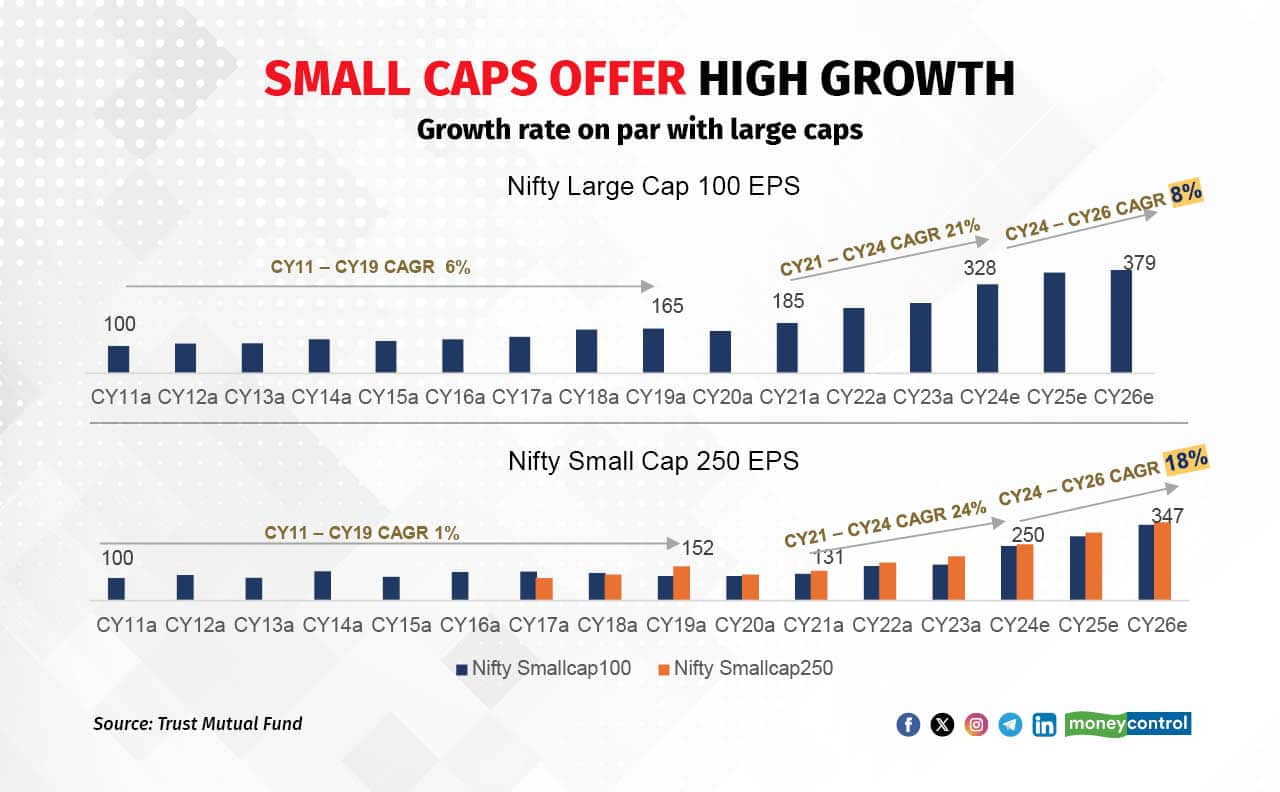



The common belief that all small cap valuations are high is not true, says Mihir Vora, chief Investment Officer, Trust Mutual Fund.
One needs to focus on companies – within the small-cap space -- with positive earnings and such entities have huge growth potential, making them attractive investment opportunities, he said while adding that external factors have distorted the broader view of the market.
“For the sake of analysis, we removed loss-making companies (from the analysis). One or two big losses can skew the aggregates. But if you focus on companies with positive earnings over the years, you’ll see a different picture,” he said while speaking at the launch of Trust MFs Small Cap Fund NFO.
This analysis, according to Vora reveals that valuations of small-cap stocks are largely in line with large-caps. “The large-cap P/E and the small-cap P/E are approximately the same,” he said adding that large-cap P/E is actually slightly higher.
“There's a bit of a skew because multi-cap and flexi-cap funds are pouring money into the 150 stocks classified as large caps. But when you look at the actual valuations of large caps and small caps, they're pretty similar,” he said.

According to Vora, what really makes small caps stand out is their growth potential. “The growth rate expected for small caps is significantly higher. While large caps are expected to grow at a rate of 8 to 12 percent, small caps are poised for growth of around 18 percent. So, when you adjust for growth, small caps actually offer a better risk-reward equation.”
Another key metric, according to Vora, that supports the case for small caps is the PEG ratio (price-to-earnings growth ratio), which factors in growth expectations.
“If you look at the next two years of growth and forward price-to-earnings, the PEG ratio for small caps is around 1, which is very reasonable. It's actually a bit higher for large caps. So, in terms of valuation, small caps aren’t much of a concern," he said.
Vora noted that small-cap category has delivered good absolute returns and strong alpha generation. "This is where the opportunities lie if you can identify the right stocks earlier than the broader market," he said.
Vora added the market has been rewarding companies that have shown earnings growth and punishing those that have disappointed. "The market is rewarding stocks where profits are growing and estimates are being upgraded, while punishing those where earnings have disappointed. This suggests the market is operating quite rationally."
Terminal Value ModelVora also suggested the importance of using a terminal value model in assessing small caps. Terminal Value is the value of an asset beyond the forecasted period when future cash flows can be estimated.

"Our philosophy gives equal importance to growth and valuation, with a very keen eye on terminal value. This is crucial because it not only looks at short-term growth but also the sustainability of that growth over the long term."
According to him, the terminal value investing model is particularly suited to small caps because they are often in the highest growth phase of their lifecycle.
"Small caps fit beautifully with our terminal value investing philosophy. It's the highest growth phase in a company's life cycle. The small-cap universe is not small anymore; in fact, it accounts for about 40 percent of the market. Many of the high-growth stocks, sectors, and themes are found within this space."
One particular instance, according to Vora, is the defence manufacturing space.
"We’re starting from scratch in defence manufacturing, and within just a few years, domestic production has grown to 1.2 lakh crore, with exports contributing around 20,000 crore. The domestic procurement market for defence is expected to grow to 8-10 lakh crore in the next 5-7 years, with the majority of that coming from domestic suppliers. This provides a clear runway for growth over the next decade," he said.
Vora also cited the examples of the pharmaceuticals and IT space, where the private sector was allowed to flourish. "There was no pharma industry in the 1960s, and today we’re the world leader in pharmaceutical production. The same happened with IT services in the 1970s. When the private sector is given the opportunity, it becomes world-class. The defence sector is now following a similar trajectory," he explained.
Vora noted that it is a great time to be looking at small caps given the momentum in both the domestic and global economy, as well as the early growth trends. "Small caps offer a unique and compelling opportunity for long-term wealth creation," he said.
Disclaimer: The views and investment tips expressed by investment experts on Moneycontrol.com are their own and not those of the website or its management. Moneycontrol.com advises users to check with certified experts before taking any investment decisions.Discover the latest Business News, Sensex, and Nifty updates. Obtain Personal Finance insights, tax queries, and expert opinions on Moneycontrol or download the Moneycontrol App to stay updated!
Find the best of Al News in one place, specially curated for you every weekend.
Stay on top of the latest tech trends and biggest startup news.